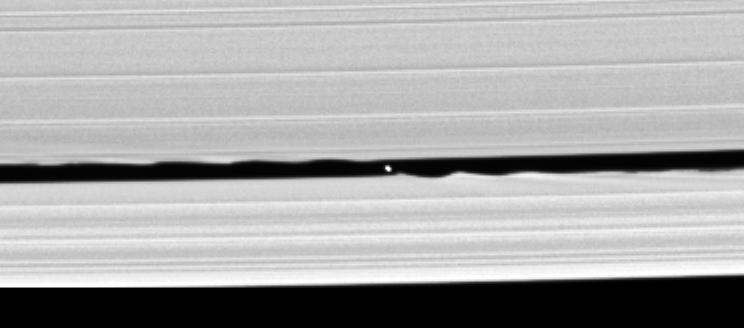Wavemaker Moon

| PIA Number | PIA06237 |
|---|---|
| Language |
|
Cassini's confirmation that a small moon orbits within the Keeler gap in Saturn's rings is made all the more exciting by this image, in which the disk of the 7 kilometer-wide body (4-miles) is resolved for the first time.
The new body, provisionally named S/2005 S1, was first seen in a time-lapse sequence of images taken on May 1, 2005, as Cassini began its climb to higher elevations in orbit around Saturn (see Discovery of the Wavemaker for the movie). This view was acquired one day after the discovery sequence of images and has allowed scientists to measure the moon's size and brightness.
In the vicinity of the little moon, the Keeler gap edges bear striking similarities to the scalloped edges of the 322 kilometer-wide (200-mile) Encke gap, where the small moon Pan (25 kilometers, or 16 miles across) resides. From the size of the waves seen in the scalloped edges of the Encke gap, imaging scientists were able to estimate the mass of Pan. They expect to do the same eventually with S/2005 S1.
This image was obtained with the Cassini spacecraft narrow-angle camera on May 2, 2005, at a distance of about 594,000 kilometers (369,000 miles) from Saturn. Cassini was about 525,000 kilometers (326,000 miles) above the ringplane when the image was taken. Resolution in the original image was 3 kilometers (2 miles) per pixel. The image has been magnified by a factor of two, and contrast has been enhanced, to aid visibility of the small moonlet.
The Cassini-Huygens mission is a cooperative project of NASA, the European Space Agency and the Italian Space Agency. The Jet Propulsion Laboratory, a division of the California Institute of Technology in Pasadena, manages the mission for NASA's Science Mission Directorate, Washington, D.C. The Cassini orbiter and its two onboard cameras were designed, developed and assembled at JPL. The imaging team is based at the Space Science Institute, Boulder, Colo.
For more information about the Cassini-Huygens mission visit http://saturn.jpl.nasa.gov . For additional images visit the Cassini imaging team homepage http://ciclops.org .
Credit: NASA/JPL/Space Science Institute
